Turner Contemporary: Did art transform 'no-go zone' Margate?
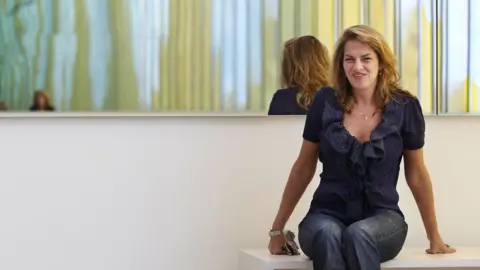 Getty Images
Getty ImagesMargate's £17.5m art gallery Turner Contemporary opened in 2011 with hopes it would spearhead the regeneration of one of the most deprived parts of the UK. Since then the gallery has had several hit shows and is hosting this year's Turner Prize. But how much has it changed the surrounding town?
Tracey Emin grew up in Margate in the 1970s, when the north Kent resort was still attracting crowds of holidaymakers to its "golden mile" of sand, jellied eels, buckets and spades and Kiss Me Quick hats.
But by the 1980s the town had become a "no-go zone", she recalls.
As visitors found other destinations abroad, Margate - like other seaside resorts - had fallen into sharp decline.
At its lowest ebb, it was an unloved town of boarded-up shops, deserted trains, empty streets and derelict arcades. Its theme park had closed and it was home to some of the poorest communities in the country.
Emin has never wavered in her passionate support for her hometown, believing in its beauty, its sunsets and skies. These famously also inspired the Romantic artist JMW Turner, after whom both the Turner Prize and the Turner Contemporary are named.
 Getty Images
Getty ImagesThe brand new glass-clad Turner Contemporary opened its doors eight years ago on the seafront site of a cottage where JMW Turner had stayed.
Emin predicted visitors would discover a "different, edgy, sexy" town.
Since those first visitors arrived, the town has undergone a transformation.
The theme park Dreamland has reopened, the quaint streets of the Old Town have filled up with quirky cafes, stylish restaurants and vintage shops, and across the town, galleries, studios and cottage industries have opened.
Rambling old houses have become desirable again and even the gardens have been smartened up.
Now Margate makes the news for its hipsters, its London cool and celebrity residents, such as The Libertines frontman Pete Doherty.
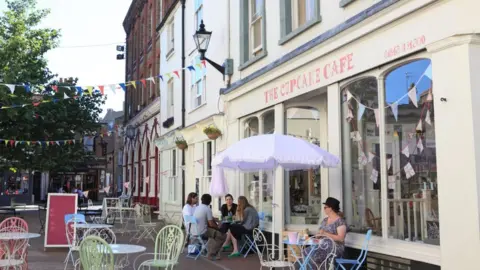 Alamy
AlamyFigures show thousands of people visit the town each day.
"Now there are new restaurants, there's a vintage theme park, there are thousands of people on the streets, people on the beaches, people on the harbour arm, people dancing, people swimming, the caves have reopened, the shell grotto has never had so many visitors, the trains are so busy you can't get a seat," says Emin.
But despite the success questions remain whether Margate's regeneration is skin deep.
Dan Thompson, an artist, lives in the 1960s tower block Arlington House that overlooks the railway station and sees the crowds of visitors arriving in the town each day.
He welcomes the "fancy galleries" but says Margate still has social problems that the gallery has not improved.
"We've still got to make that real, deep lasting change," he says.
Economic data bears this out. Latest figures issued last week by the Ministry of Housing, Communities and Local Government show the area around Turner Contemporary is still one of the 1% most deprived in the country.
You may also be interested in:
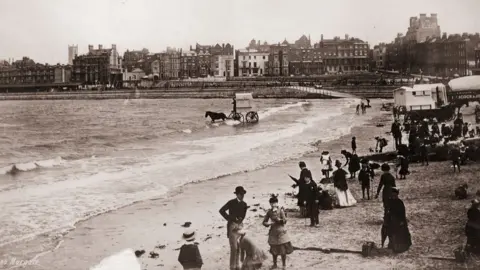 Getty Images
Getty Images Getty Images
Getty ImagesWhile this represents an improvement on the picture in 2010, when the area was among the UK's 0.3% most deprived it follows a five-year period after the gallery's opening in which there was no significant change.
Others claim the gallery does not do enough to help struggling artists.
Dr Jonathan Ward, who has researched the gallery's impact on the town, cites the story of a local artist as evidence.
"She was putting on a show but she wasn't allowed to put her flyers for the show in Turner Contemporary because it would spoil their attractive and very thought-out, cool interior to have a row of flyers, so she went in the toilets and hid them there," he says.
"There are clearly people in Margate doing work out of Turner Contemporary. One of the greatest things they're doing is the cafe is buying all fresh produce from a place up the road, so keeping some money in the local economy.
"But I'm quite critical of Turner Contemporary because it's not done enough to support the local creative community."
But Emin, who is now the Royal Academy's professor of drawing, strongly disagrees.
She says the gallery's impact on Margate is proven by the footfall in the town and at the gallery. She also claims the gallery has led to more students studying GCSE and A-level art in the town.
"That's the improvement people need," she says. "Many wanted more from the money that was spent without realising the real effects. I don't agree with that."
 Getty Images
Getty ImagesIn its first eight years, the gallery, under Victoria Pomery's directorship, has hosted big-name shows including Rodin's The Kiss and Emin's My Bed.
Its latest coup came on Saturday when it unveiled the Turner Prize shortlist to the public. Nearly 10,000 people came through its doors over the weekend, making it the gallery's busiest autumn yet.
In total it has received more than 3.3m visits since it opened in 2011 and in that time visitor numbers to Thanet - the council area Margate sits within - have risen by one million.
The local authority says tourists cite the gallery and Dreamland as their main reasons for visiting.
The area's economy has also grown by £89m since 2011 and the number of jobs has increased from 5,477 to 7,950.
Some say the town's high-speed rail service, which since 2009 has made the town more attractive to London commuters, is responsible for much of this boom.
But it seems indisputable that the gallery itself has had a positive impact on the town too.

How much change has there been?
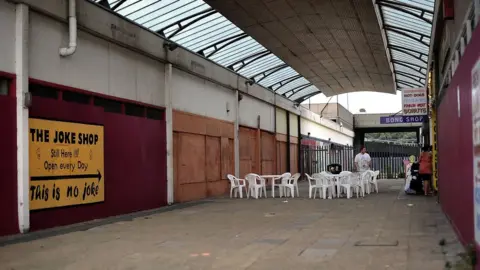 Getty Images
Getty ImagesOfficial deprivation figures released in September show the area of Margate around Turner Contemporary was among the most deprived 1% of neighbourhoods in England.
As of 2019, it is the 139th most deprived out of more than 32,800 neighbourhoods, Ministry of Housing, Communities and Local Government (MHCLG) figures show.
In 2010, it was 81st most deprived but it slipped further down the rankings in 2015 to 21st before its score changed again in the latest data.
The adjoining neighbourhood, Cliftonville West, was the 117th most deprived in England, an improvement on being ranked fourth most deprived in 2015, but still well within the 1% most deprived. In 2010 it was England's 33rd most deprived neighbourhood.
Rankings for deprivation are based on a combination of factors including income, employment, education, skills and training, health and disability, crime, housing and living environment.
Source: MHCLG

Dr Andrew Jackson, an expert in advertising, marketing and arts management, says research has shown half the people who visit Margate would not do so if the gallery was not there.
Local businesses even see a downturn when the gallery is between exhibitions, he adds.
Dr Jackson, who acts as a consultant to the gallery, says: "That's a really clear indication their success depends on the gallery and its funding."
Kate Kneale, a designer who left London and moved to Marine Studios in Margate in 2009, has seen it all happen.
She remembers how the gallery opened in a "broken, challenged" town but said the gallery had "played its part in spades" in the town's success.
The town has also seen a passion for art sweep through its schools, according to Katie Green, at Ramsgate's Harbour Academy.
She said students were more openly talking about art, were more engaged in lessons and wanted to do art in their spare time. Year 7 and Year 9 pupils are also currently engaged in projects based at the gallery.
Meanwhile, the Margate Art School is launching its master of fine arts degree in October and attributes its uptake to the gallery's reputation and profile.
Director Uwe Derksen said: "Turner helps the atmosphere. It helps to have the Turner Prize, it's an uplift. People think 'this is a place where I want to study'."
Emin herself is now based in a studio in her hometown following a career that has taken her across the globe.
She insists: "Margate hasn't had a boom like this for 40 years and I do attribute it to the gallery, 100%.
"This is because of art. This is only a good thing."

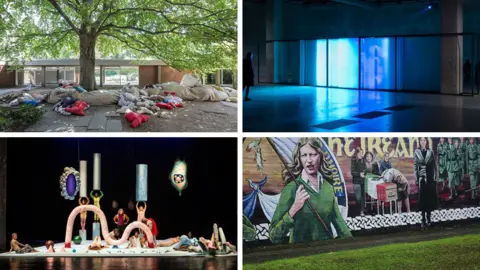 Oscar Murillo/Lawrence Abu Hamdan/Helen Cammock/Ta
Oscar Murillo/Lawrence Abu Hamdan/Helen Cammock/Ta'Highest honour'
The Turner Prize is an annual award given to a visual artist born in or based in Britain. It is considered the British art world's highest honour.
It was established in 1984 to promote new developments in contemporary art and often brings fierce debate about artists and the definition of art.
The exhibition used to be held in London but now alternates yearly between Tate Britain and a gallery outside the capital.
In the 1990s, artists including Damien Hirst and Emin sparked controversy for the provocative, often conceptually-driven works they showcased.
The winner of the Turner Prize receives £25,000, with the three other short-listed candidates receiving £5,000 each.

